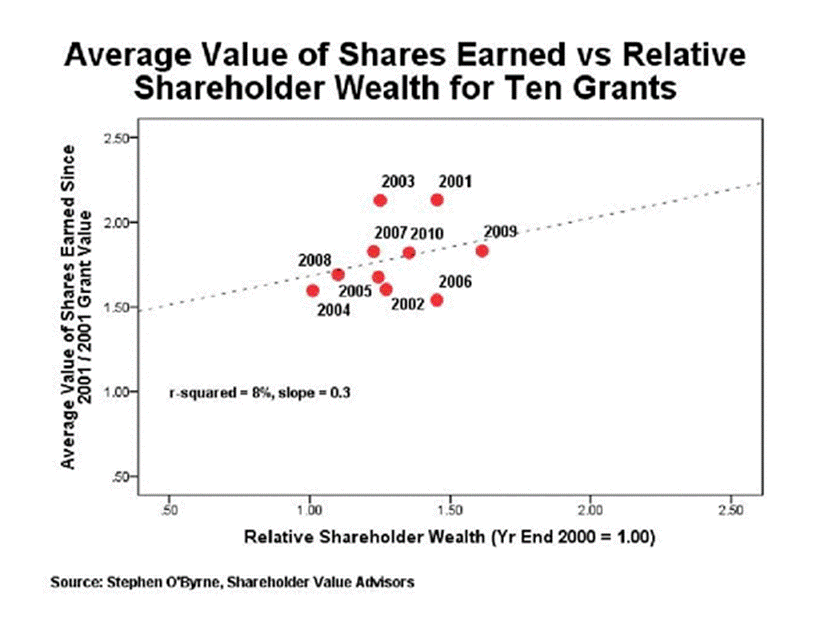|
THE
WALL STREET JOURNAL.
Risk & Compliance
Journal.
February 11, 2014,
6:00 AM ET
Inside Intel: Pay for Performance
Questioned
By
Gregory J. Millman
Wall Street Journal
Intel
Corp. touted recent changes to its executive compensation program
in a letter to shareholders as catalysts for a “cultural shift,”
writing, “Our goal is for executive compensation to be well aligned
with stockholders’ interests.” Yet compensation consultants contacted
by the Wall Street Journal said the changes are minor, and even Intel
agreed.
|

Getty Images
Intel logo
|
The
lesson is that when companies talk about executive compensation, it’s
important to pay attention to the details. Intel says that its
compensation program aligns executives with shareholders, but there is
an important difference between executives and other shareholders.
Executives get fresh equity grants every year, and when the stock
price falls, those grants have more shares. Executives have to earn
those grant shares by meeting total shareholder return targets, but
after a stock price falls, they are also working toward those targets
from a lower base.
As a
result, an analysis by the compensation consulting firm Shareholder
Value Associates found, even if the new plan had been in place since
2001, the alignment of compensation and shareholder value would have
been weak. “What they are doing is to use a little sleight of hand to
deliver something close to what they were delivering before but make
it look different,” said Andy Restaino, managing director of another
compensation consultancy, Technical Compensation Advisors Inc.
Britt
Wittman, director of executive compensation at Intel, also said in an
interview that the changes are less than massive: “The reason they are
not a huge redo of the compensation program [is that] we feel it had a
fair amount of pay for performance in it, and weren’t looking to
change the fundamentals or underlying philosophy.”
Mr.
Wittman said that the company responded to last year’s disappointing
say-on-pay vote, in which only 68% of voters approved the compensation
plan. He blamed two factors for the anemic support. First, Intel had
given retention stock awards to some top Intel executives who had lost
in the race to succeed departing Chief Executive Paul Otellini.
(Current CEO Brian Krzanich won the slot.) Second, Intel’s performance
share plan cushioned the downside so executives would have a soft
landing even if shareholder value tanked.
So in its
recent letter to shareholders, Intel confirmed there will be no
retention awards this year, and announced tweaks to the rules on those
performance shares, most notably eliminating a guarantee that made the
downside more comfortable for executives.
In the
past, no matter how badly Intel fared, executives could claim some of
those shares. The new rules say that if Intel underperforms its peers
by 25% or more, the executives don’t get any of them. Intel uses a
graph to make its case that the changes mean a strong a
pay-performance linkage.
The
curves for payouts on both old and new rules are quite close even in
Intel’s graph. Under both, there seems to be a strong relationship
between how Intel’s total shareholder return compares to peers’ and
the shares executives get.
But the
Intel graph only looks at how executives earn shares once they’ve been
granted. It doesn’t address how many shares get granted, that is, how
many they are eligible to claim based on performance. In fact, every
year, executives get a new grant of equity shares and when the stock
price falls, there are more equity shares in those grants. See the
graph below, which tracks Intel’s equity awards to CEOs from
2001-2012:
Because
the grants can be earned, or not, over a three-year plan, when
executives receive new grants, they are usually still working to earn
shares awarded under prior year’s grants.
Shareholder Value Advisors prepared an analysis of Intel CEOs’
cumulative average pay over time from multiple grants. The picture
looks quite different from the payout under a single grant. Here’s how
the equity compensation of Intel’s CEOs would have compared to
relative shareholder value had the new program been in place from
2001-2012. It seems that the practice of awarding more stock when the
stock price falls overwhelms the pay-for-performance linkage in a
single grant.
In
November Sanford Bernstein analyst Stacy Rasgon downgraded Intel to “underperform.”
Mr. Rasgon responded “No” to our email asking whether he expected the
new compensation program to make a difference in the company’s
performance. In light of the analysis, it’s understandable why it
shouldn’t.
Intel’s
Mr. Wittman said that the company itself had not done an analysis of
the cumulative effect of stock grants on pay-for-performance linkage
over time. “We do discrete analysis and to the best of my knowledge
that’s the way everybody is doing it,” he explained. He said that the
company’s practice of giving executives a dollar award translated into
shares of stock treats them something like an investor who is
dollar-cost-averaging by putting a fixed amount of dollars into shares
periodically.
But the
pay-for-performance relationship under multiple grants, as analyzed by
Shareholder Value Advisors, looks much different than Intel’s picture
of that relationship under a discrete grant. The long term is not just
a series of short terms, in this case.
(Gregory
J. Millman is a senior columnist with Risk & Compliance Journal He is
the author of The Vandals’ Crown: How Rebel Currency Traders Overthrew
the World’s Central Banks, and several other books. He can be reached
at +1 (212) 416-2352 or by email at gregory.millman@wsj.com
Follow on Twitter @GregoryJMillman)
|



